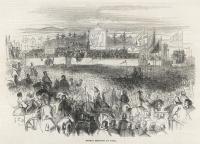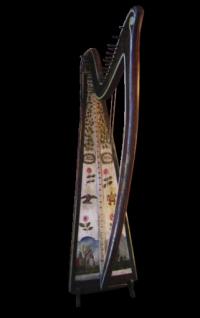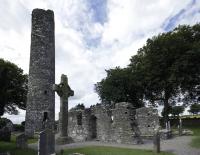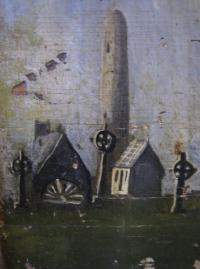A Drogheda harp: instrument and icon
Published in
18th–19th - Century History,
Early Modern History (1500–1700),
Features,
General,
Issue 1(Jan/Feb 2013),
Volume 21

Daniel O’Connell’s ‘monster meeting’ at the Hill of Tara on 15 August 1843 as depicted in The Illustrated London News. Note the aged harper in bardic dress playing the harp, placed at the centre of the picture for maximum symbolic effect.
Harps have been associated with Ireland since ancient times, when harpers were the musicians maintained by chiefs and kings. In the 1500s the harp became the symbol of Ireland itself on the coins of Henry VIII, the first ‘king of Ireland’. After the collapse of the Gaelic order, harpers still found patronage among the aristocracy in the ‘big houses’. But by the late 1700s musical tastes had changed and only a few harpers remained. The antiquarian Joseph Cooper Walker, in Historical memoirs of the Irish bards (1786), drew attention to the plight of the harpers and the importance of preserving the harp tradition. The Irish harp was now perceived as a relic of the glorious past, along with round towers and wolfhounds. It also symbolised an independent nation, and a winged-maiden harp emblem was adopted by the Volunteers in 1778 and by the United Irishmen in the 1790s.
Monster meeting at Tara

One of the Drogheda harps, played by the student William Griffith at the Tara monster meeting in 1843, that has remained in the ownership of a Drogheda family for several generations.
In the 1840s the harp image was often a depiction of an actual instrument, the iconic Trinity College harp, as pictured on membership cards of the Repeal Association. Led by the charismatic Daniel O’Connell, the Repeal Association held ‘monster meetings’ at various sites around the country, attended by hundreds of thousands of people. The most famous, on 15 August 1843, was held at the Hill of Tara, a site of ‘ancient importance’ as the seat of former high kings. A picture in The Illustrated London News conveys the vast crowd, waving banners with pictorial symbols of towers, wolfhounds and harps. Our eyes are drawn to the centre of the picture, where an aged harper in bardic dress plays his harp, placed for maximum symbolic effect. It is also a ‘snapshot’ of an actual harp played at the meeting:
‘The old harper touched the chords of his harp, but sounds died upon the strings themselves, the voice of half a million shouting welcome to their Liberator, and hurrah for Ireland, could alone be heard’.
Earlier that day, the national instrument was even played at the Liberator’s breakfast, in the home of Mr McGarry. The harper was ‘clothed in antique Irish costume’, and he ‘continued during the repast to play the beautiful airs of our country’.
Ancient minstrels received press coverage in the report on the Tara Hill meeting, but it is interesting to learn that another group of young harp-players also performed that day. Patrick Cooney’s article, ‘Drogheda Harp Society’, in the Journal of the Old Drogheda Society relates that five students from the harp society played a welcome to Daniel O’Connell at the meeting. One of the harps, played by the student William Griffith, still survives. This extraordinary instrument has remained in the family for several generations. The Drogheda Harp Society was started on 15 January 1842 by Fr Thomas Burke, OP, who appointed Hugh Frazer as teacher for the school. With a link to the old harping tradition, Frazer had learned his craft from Edward McBride at the Belfast Harp School in 1821. He had been listed as a pupil, aged thirteen, and he seems to have not been blind.
The Drogheda Harp Society was the last remaining institution to teach the Irish harp, since the Belfast Harp School had recently closed in 1839, owing to lack of funds, and the Dublin Harp Society had lasted only from 1809 to 1812. In April 1843 Fr Burke submitted the first annual society report in The Nation newspaper, titled ‘Temperance and minstrelsy’. In common with earlier harp societies, the founders desired ‘to create a new order of minstrels’, but there was also a new driving force ‘to elevate national morality’. The society, aligned with the temperance movement and the Catholic faith, believed that if young boys were occupied with learning to play the harp they would certainly reject the temptations of alcohol. In addition to Irish music, the young pupils were taught to play ‘vespers and other sacred melodies’. It was a successful venture by all accounts; Fr Burke reported that ‘there are in our Harp Society fifteen pupils, many of whom can play with admirable skill, and ’ere long they will be highly qualified to instruct others’. Twelve harps of ‘Drogheda manufacture’ were purchased for their use, costing £36, or £3 each.
The harp’s artistry and construction

Monasterboice today and as depicted on the harp, not as ruins but with roofs. (Kevin King).
The surviving Drogheda harp is important not only for its historical significance but also for its interesting artistry and construction. Timber for the Drogheda harps was supplied by Mr Ball of Ballsgrove House, and a local craftsman, Francis Flood, oversaw their construction and decoration, with the boys working on their own harps. A newspaper article on the society from 1844 states that ‘Among the pupils are two blind boys’, suggesting that most boys had their sight. William Griffith was not blind and it is tempting to imagine him painting parts of his harp. Upon seeing the brightly coloured paintings on the harp’s soundboard a first impression is one of amazement. Rather like an artist’s canvas, a white background is filled with stirring images, including a portrait of Brian Boru and a landscape painting of Monasterboice. The harp has a high-headed shape and a rounded back soundbox with three sound-holes. About 5ft tall, most of the instrument is painted dark brown, with lighter strokes added to simulate the grain of a more expensive wood, like mahogany. All the edges on the harp are painted in gold.
Fr Burke described the harp design thus: ‘[we have] by our improvement on the construction of the national instrument, given to it imperishable strength’. Indeed, the back of the soundbox is unusual, with an extra overlapping section at the top, rather like a fitted sleeve, adding thickness, strength and support. A thin iron band was added to the bottom surface of the neck to prevent twisting, and on the rounded end of the neck (knee-block) a metal plate is attached with nails. The harp has 40 string-holes and, although a few old gut strings remain, it most certainly would originally have been strung with brass wire strings, like the harps from the Belfast School.
Clearly, the symbols painted on the soundboard were carefully chosen to communicate messages of faith and patriotism. Strands of plump shamrocks in a figure-of-eight pattern fill the upper area, and wreaths of shamrocks encircle patriotic inscriptions in Gaelic. On the left (facing) is the popular slogan ‘Eiren [sic] go-bragh’ (‘Ireland forever’), still found on today’s souvenir t-shirts from Ireland. On the right side is ‘Eire óg’ (‘Young Ireland’), for the group of young activists led by Thomas Davis, who founded The Nation newspaper to assist the Repeal campaign. The inscription underneath, ‘Inis na Naein’, is less clear. It may refer to Ireland as ‘Inis na Naoimh’ (‘Island of Saints’). It is quite possible that the patterns of shamrocks, wreaths and Gaelic inscriptions were inspired by similarly decorated harps made for the Belfast Harp Society by John Egan of Dublin, as seen in the collection of the National Museum of Ireland.
Symbols of the Catholic faith appear in the next section, on the right (facing), with a papal crown and the crossed keys of St Peter in gold, draped with red banners. Across on the left is an eagle with a shield in red and gold with a Christian cross. The bird is somewhat similar to the eagle on the American great seal, and perhaps suggests a sympathetic connection to America. Around both images are radiant brush strokes suggesting importance, and single roses in pink fill the spaces above and below.

At the base of the harp is a painting of
Brian Boru, or Brian Bóroimhe, high king of Ireland, who defeated the Norsemen. Wearing armour and antique crown, he holds a sceptre in his right hand, and his left hand rests on a shield with three lions. Beside him is a table with draped banner bearing a winged-maiden harp, and on the table is a Milesian crown. A curious stone marker appears in the background, perhaps a local landmark. This scene of Brian Boru is taken from a famous illustration by an unknown artist, frequently reproduced, and an early version was published in 1723 in Geoffrey Keating’s History of Ireland. The charming painting of Monasterboice on the bottom right of the harp may also have been inspired by a printed illustration. Ireland’s antiquities and past architectural achievements were given new importance by historians such as George Petrie, whose research and woodcut illustrations appeared in historical guides published by the Royal Irish Academy. The painted scene of Monasterboice, with architectural treasures of Celtic crosses, churches and round tower, strongly resembles a print in Archaeologica Hibernica (1848), published by William Wakeman, except that the Drogheda artist has represented the churches not as ruins but with roofs. A nice touch in the overall composition of these two paintings is how the artist has shaped them at the top with rounded architectural arches. Below the left-hand painting is an artist’s signature, A. Dalton.
End of the nineteenth-century harp revival
![‘Eiren [sic] go-bragh’, ‘Eire óg’ and ‘Inis na Naein’.](https://www.historyireland.com/wp-content/uploads/2013/03/98_small_1357576713.jpg)
‘Eiren [sic] go-bragh’, ‘Eire óg’ and ‘Inis na Naein’.
Within the year, while travelling back and forth to Dublin for a conference, Fr Burke unfortunately caught a cold, which ‘fell on his lungs’ and he died suddenly. The obituary in The Nation applauded his ‘indefatigable efforts for some years past to extend the sacred cause of temperance’ and his promotion of ‘the general taste for our national instrument—the harp’. The Drogheda Harp Society ceased to exist the following year, 1845. The Famine brought an end to the efforts to revive the Irish harp.
Reflecting on the nineteenth-century Irish harp revival movement, a popular perception is that the Irish harp and its music had long since gone out of fashion and that revival efforts could not have succeeded. The pianoforte and the French pedal harp were the instruments of choice played by the aristocracy and gentry. The chromatic art music of the day was more idiomatic to these instruments, in contrast to the wire-strung Irish harp tuned in fixed modes. In addition to teaching students to play the Irish harp, the stronger motivation for the harp societies may have been the political desire to ‘save’ the national symbol. Fr Burke did achieve success with the last harp school, and today the Historical Harp Society of Ireland is once again reviving the wire-strung Irish harp. The music lives on, as does the ever-present harp symbol. HI
Nancy Hurrell is a harp consultant at the Museum of Fine Arts, Boston, and a member of the harp faculty at the Boston Conservatory.
Further reading
B. Boydell, ‘The United Irishmen, music, harps and national identity’, Eighteenth-Century Ireland 13 (1998), 44–51.
C.M. Fox, Annals of the Irish harpers (New York, 1912).
J. Sheehy, The rediscovery of Ireland’s past: the Celtic Revival 1830–1930 (London, 1980).
![One of the three sound-holes in the rounded back soundbox. Note the addition of a thin iron band to prevent twisting: ‘[we have] by our improvement on the construction of the national instrument, given to it imperishable strength’—Fr Burke.](https://www.historyireland.com/wp-content/uploads/2013/03/98_small_1357576780.jpg)
One of the three sound-holes in the rounded back soundbox. Note the addition of a thin iron band to prevent twisting: ‘[we have] by our improvement on the construction of the national instrument, given to it imperishable strength’—Fr Burke.



 At the base of the harp is a painting of Brian Boru, or Brian Bóroimhe, high king of Ireland, who defeated the Norsemen. Wearing armour and antique crown, he holds a sceptre in his right hand, and his left hand rests on a shield with three lions. Beside him is a table with draped banner bearing a winged-maiden harp, and on the table is a Milesian crown. A curious stone marker appears in the background, perhaps a local landmark. This scene of Brian Boru is taken from a famous illustration by an unknown artist, frequently reproduced, and an early version was published in 1723 in Geoffrey Keating’s History of Ireland. The charming painting of Monasterboice on the bottom right of the harp may also have been inspired by a printed illustration. Ireland’s antiquities and past architectural achievements were given new importance by historians such as George Petrie, whose research and woodcut illustrations appeared in historical guides published by the Royal Irish Academy. The painted scene of Monasterboice, with architectural treasures of Celtic crosses, churches and round tower, strongly resembles a print in Archaeologica Hibernica (1848), published by William Wakeman, except that the Drogheda artist has represented the churches not as ruins but with roofs. A nice touch in the overall composition of these two paintings is how the artist has shaped them at the top with rounded architectural arches. Below the left-hand painting is an artist’s signature, A. Dalton.
At the base of the harp is a painting of Brian Boru, or Brian Bóroimhe, high king of Ireland, who defeated the Norsemen. Wearing armour and antique crown, he holds a sceptre in his right hand, and his left hand rests on a shield with three lions. Beside him is a table with draped banner bearing a winged-maiden harp, and on the table is a Milesian crown. A curious stone marker appears in the background, perhaps a local landmark. This scene of Brian Boru is taken from a famous illustration by an unknown artist, frequently reproduced, and an early version was published in 1723 in Geoffrey Keating’s History of Ireland. The charming painting of Monasterboice on the bottom right of the harp may also have been inspired by a printed illustration. Ireland’s antiquities and past architectural achievements were given new importance by historians such as George Petrie, whose research and woodcut illustrations appeared in historical guides published by the Royal Irish Academy. The painted scene of Monasterboice, with architectural treasures of Celtic crosses, churches and round tower, strongly resembles a print in Archaeologica Hibernica (1848), published by William Wakeman, except that the Drogheda artist has represented the churches not as ruins but with roofs. A nice touch in the overall composition of these two paintings is how the artist has shaped them at the top with rounded architectural arches. Below the left-hand painting is an artist’s signature, A. Dalton.![‘Eiren [sic] go-bragh’, ‘Eire óg’ and ‘Inis na Naein’.](https://www.historyireland.com/wp-content/uploads/2013/03/98_small_1357576713.jpg)
![One of the three sound-holes in the rounded back soundbox. Note the addition of a thin iron band to prevent twisting: ‘[we have] by our improvement on the construction of the national instrument, given to it imperishable strength’—Fr Burke.](https://www.historyireland.com/wp-content/uploads/2013/03/98_small_1357576780.jpg)
















